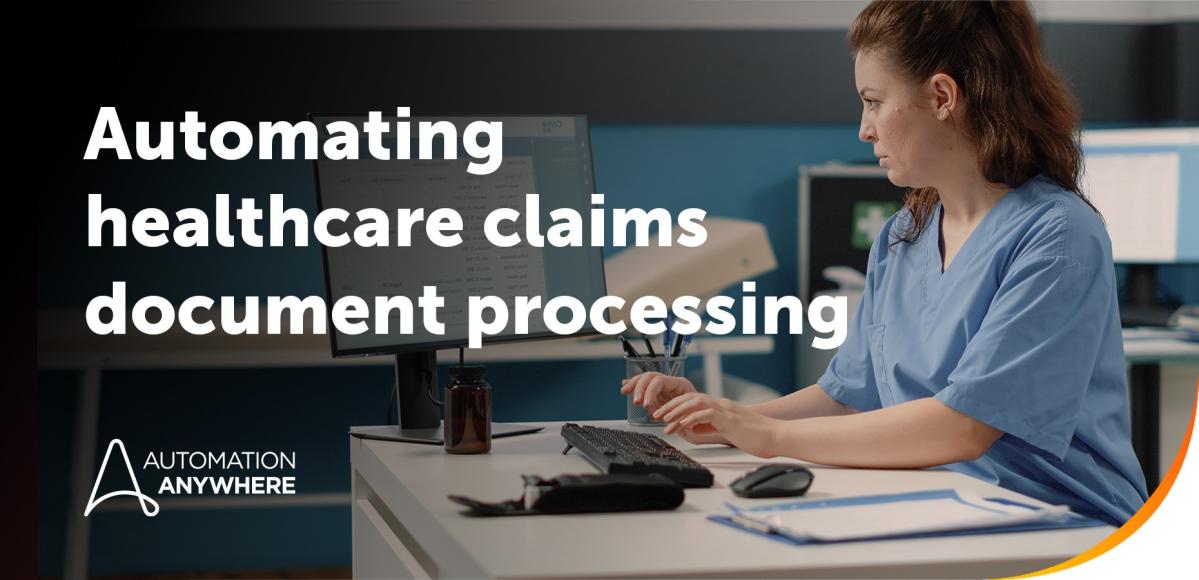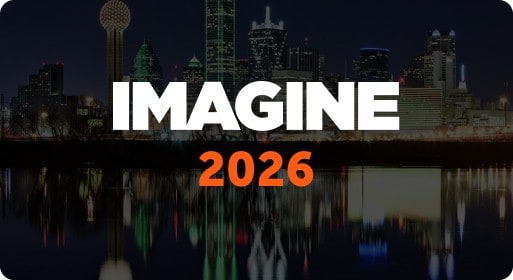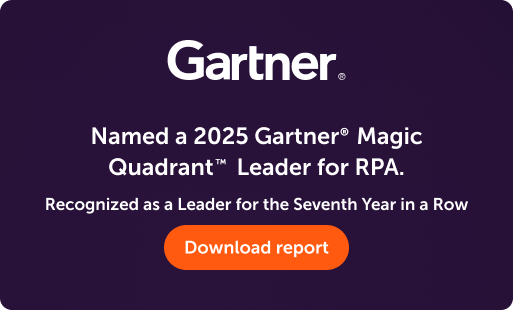- Login
- Search
- Contact Us
-
Have a question? Our team is here to help guide you on your automation journey.
-
Explore support plans designed to match your business requirements.
-
How can we help you?
-
- AI
AI Without the Hype From pilot to full deployment, our experts partner with you to ensure real, repeatable results. Get Started
- Automation Anywhere AI
-
- Solutions
Featured Agentic Solutions
Accounts Payable Invoice automation—No setup. No code. Just results. Accounts Payable
Customer Onboarding Scale KYC/AML workflows. Customer Onboarding
Customer Support Keep queues moving, even at peak load. Customer Support
Healthcare RCM Revenue cycle management that runs itself. Healthcare RCM
- Products
Platform Features
- Agentic process automation (APA)
- Robotic Process Automation (RPA)
- View all Products
-
- Resources
Get Community Edition: Start automating instantly with FREE access to full-featured automation with Cloud Community Edition.
Featured
 Named a 2025 Gartner® Magic Quadrant™ Leader for RPA.Recognized as a Leader for the Seventh Year in a Row Download report Download report
Named a 2025 Gartner® Magic Quadrant™ Leader for RPA.Recognized as a Leader for the Seventh Year in a Row Download report Download report- Become an Expert
- Developer Tools
- Get Support
- View all resources
-
- Partners
Find an Automation Anywhere Partner Explore our global network of trusted partners to support your Automation journey Find a Partner Find a Partner
- Find a Partner
- For Partners
-
Blog
To Plug Healthcare’s $200B Claims Drain, Start With Documents
Navigate to content
- Improving patient outcomes and optimizing revenue by eliminating slow, error-prone, document-based tasks
- A healthcare paperwork crisis
- Eliminating document-driven bottlenecks to unlock more value
- Putting IDP to work, on documents and more
- A springboard to agentic automation
- The autonomous healthcare enterprise is here

- Improving patient outcomes and optimizing revenue by eliminating slow, error-prone, document-based tasks
- A healthcare paperwork crisis
- Eliminating document-driven bottlenecks to unlock more value
- Putting IDP to work, on documents and more
- A springboard to agentic automation
- The autonomous healthcare enterprise is here
Improving patient outcomes and optimizing revenue by eliminating slow, error-prone, document-based tasks
Delivering quality patient care is the primary goal of the healthcare industry. Realistically, that requires revenue.
Unfortunately, the U.S. healthcare industry spends $1 trillion annually on administrative processes, with financial transactions like claims and payments processing accounting for $200 billion of that total. Drilling down, 19% of in-network and 37% of out-of-network claims are denied, forcing expensive rework of up to $118 per claim and costing hospitals alone nearly $20 billion annually. Adding cost and frustration, 85% of denials are preventable through process improvements such as automated error checking.
In the face of these and other revenue drains, healthcare organizations are under immense pressure to optimize revenue cycle management (RCM). For claims operations, that shines the spotlight on productivity, claims adjudication, coordination of benefits, reconciliation, and compliance as key areas of improvement. Yet, for all participants — providers, payers, and patients — nearly every step of the way is burdened by manual, document-based processes.
This is unsustainable for the entire healthcare industry, and frustrates patients, clinicians, and staff. Luckily, AI-enabled innovations provide a better way.
A healthcare paperwork crisis
Far beyond just claims processing, teams, processes, and revenue cycles are bogged down by a flood of documents in various formats delivered via PDFs, faxes, and scanned images, yet which are vital for delivering effective care.
Eliminating, streamlining, and automating repetitive, paper-based tasks such as claims management, appointment scheduling, and data entry is a sure way to reduce administrative burdens. Clinicians can focus more on patient care than paperwork, and back-office staff have more time and insights to improve compliance, minimize rework, predict risks, and streamline revenue cycles.
When it comes to claims processing, the sheer number and variety of documents can overwhelm even well-run operations. Many payers and BPOs still handle thousands of claims manually, which leads to more denials and costly rework. With roughly one in five claims denied, provider teams spend hours deciphering denial codes, finding clinical records, gathering documentation, and writing appeals. It’s slow, expensive, and error-prone — driving up costs, delaying payments, and leaving money uncollected.
Add in inconsistent rules, terminology, and tools across providers and payers, and the explanation of benefits (EOB) documents at the core of claims processing deliver mountains of unstructured data that is challenging to extract, understand, and use. Yet, locked away within EOBs is the information required for faster reimbursements, cleaner claims data, and better provider and patient experiences.
Payers that remain tied to manual claims processes are finding it nearly impossible to accelerate, scale, or create more accurate and consistent workflow, which slows down reimbursements and strains member satisfaction. Meanwhile, BPOs tasked with supporting providers and payers are under pressure to deliver services faster and with more accuracy while managing higher volumes and tighter margins.
Eliminating document-driven bottlenecks to unlock more value
Our Intelligent Document Processing (IDP) solution goes far beyond traditional optical character recognition (OCR), using generative AI to extract data from unstructured content, at scale, with incredible accuracy, and in real-time. IDP quickly converts EOBs into clean, structured data that then flows directly into electronic health record (EHR), claims billing systems, analytics platforms, workflows, and more.
The Process Reasoning Engine (PRE), trained on over 400 million real-world documents, data, and processes, steps in to securely orchestrate AI agents, automations, and people throughout claims processing workflows. PRE powers IDP to increase operational efficiency up to 70% while enhancing privacy, compliance, and responsible AI practices — all mission-critical in the healthcare industry.
Here’s how IDP and PRE work together to turn documents into action:
- AI adds the smarts that enable IDP to not only automate data extraction and document review processes, but to recognize patterns, make decisions autonomously, and extract information specific to claims processing and other related workflows.
- A combination of AI technologies — large language models (LLMs), computer vision, generative AI, and machine learning (ML) — vastly improve classification, extraction, and validation accuracy across all document types.
- Use of LLMs, prebuilt document models, and models trained on domain-relevant documents further ensures speed and accuracy, enabling data to move fluidly to other processes and departments such as finance, legal, compliance, and insurance.
Putting IDP to work, on documents and more
For claims processing, IDP replaces manual data entry with near-perfect data extraction, eliminates payer-specific workarounds, and scales operations without adding headcount. Healthcare payers and BPOs are transforming claims processing operations to:
- Cut EOB processing time by up to 80%
- Eliminate errors, reduce rework, and improve compliance
- Unlock insights previously buried in documents
- Scale operations without scaling headcount
- Enable seamless human-agent collaboration
Even more, IDP extracts and delivers data to other systems, AI agents, and teams, helping to automate processes, improve coordination of benefits, and enhance healthcare revenue cycle management performance. This results in claims processed up to 98% faster, claim turnaround times cut by up to 76%, and write-offs reduced by up to 50%.
Within document-dependent industries like healthcare, IDP provides a data-driven foundation for enterprise-wide automation using Automation Anywhere’s Agentic Process Automation System. Some customer successes include:
- Guidehouse, a global professional services firm, helped a health system client automate insurance eligibility verification, claims corrections, and claims resubmission processes, resulting in the elimination of over 2,000 hours of rework and a reduction in payer denials of millions of dollars.
- R1 RCM, a healthcare revenue cycle management services provider, automated 32 million tasks across claims, prior authorization, and payment and transaction posting processes.
- A global healthcare leader, which uses IDP to digitize paper-based processes, deployed automations that saved Finance 10,000 hours, identified $1 million in savings in other departments, and more.
A springboard to agentic automation
Using IDP to extract critical data from EOB documents catalyzes the jump into enterprise-wide automation, where AI agents automate processes previously deemed too difficult to run autonomously. The Agentic Process Automation System uses AI agents that reason, adapt, and orchestrate work in real-time to easily manage up to 80% of business processes, including complex, mission-critical workflows.
For example, AI agents in healthcare streamline the extraction, classification, and validation of data from paper-based and electronic health records, improving accuracy and efficiency in managing patient information. Agents can also tackle validation and fraud detection, expedite insurance claims and handle coordination of benefits, and reduce delays in the reconciliation process to improve cash flow for healthcare providers.
Organizations can begin automating claims processing with agents that resolve discrepancies in the claim submission process, trigger follow-ups and communications with providers, payers, and members, and learn from historical data to optimize EOB processing. And the agents don’t just automate tasks; they understand context, make decisions, and continuously improve, amplifying human effort along the way.
The autonomous healthcare enterprise is here
Yes, healthcare claims operations are complex. But, IDP and agentic automation have the power, intelligence, and flexibility to automate claims operations, and then quickly expand to enhance patient and clinician experiences, improve security, privacy, and compliance, streamline operations, and more.
Healthcare provider, payer and BPO leaders now have solutions to move faster, operate smarter, and deliver better outcomes — for patients, providers, payers, and all stakeholders, and far beyond claims processing. Agentic automation is here to lower costs, increase productivity, reduce delays, manage risks, and improve experiences across healthcare workflows.
Learn more about how AI agents can drive more efficiency in EOB processing in our on-demand webinar.
About Stelle Smith
A senior healthcare sales engineer at Automation Anywhere, Stelle has more than 20 years of experience in the field. He is a subject matter expert on clinical and RCM workflow and is a certified CPC and CCS medical coder.
Subscribe via Email View All Posts LinkedInAuthor's recent posts
Get to know the Agentic Process Automation System.

For Students & Developers
Start automating instantly with FREE access to full-featured automation with Cloud Community Edition.


